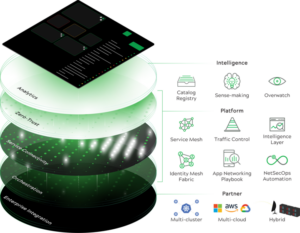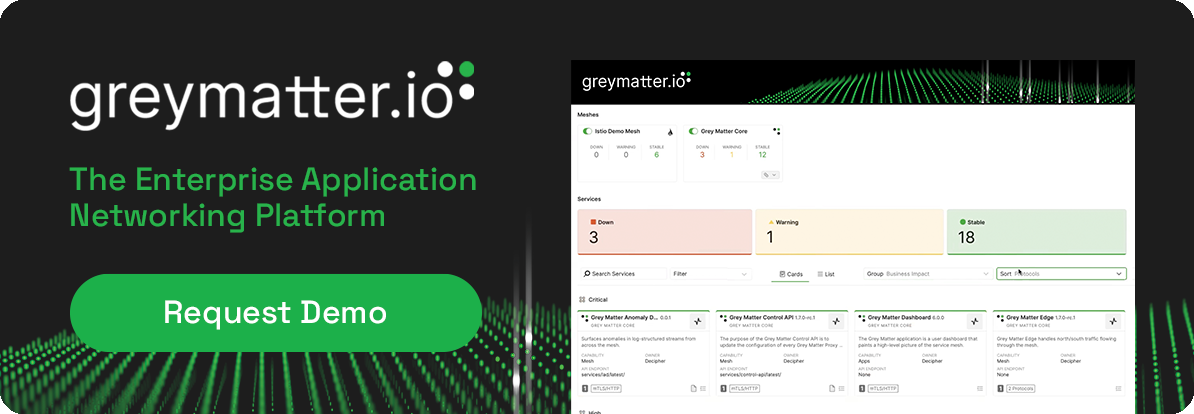blog
Putting Service Mesh in Its Place
Enterprises need to control
the complexity of modern applications.

October 3, 2023
Back in 2019, Gartner® predicted that the worldwide public cloud services market would reach 331 billion by 20221. Little did we know that in 2020, catalyzed by the pandemic, worldwide spending for cloud services would accelerate dramatically, topping 490 billion by 2022 – roughly 150% higher than anyone would have anticipated2.
An entry point
During that period, some large organizations turned to open-source service meshes as a way to tackle the complexity software development and DevOps teams encountered as they adopted cloud-native services from multiple cloud vendors, along with microservices, containers, API-based communications, and agile software development to accelerate application delivery. Service meshes provide a de-coupled layer away from the application code. They are designed to control configuration policies, route internal east-west application traffic, and enforce security across connected microservices, APIs, and data sources.
As an entry point, service meshes did their job, particularly in static, small-scale, Kubernetes environments. However, in a webinar with Howard Holton, CTO of GigaOm, our CTO Jonathan Holmes explained, “As service meshes start to grow beyond a handful of services, the complexity starts to spiral out of control. Two of the biggest challenges include the massive configuration sprawl and a skills gap associated with running and maintaining the service mesh as it is pushed into production.”
It’s not surprising that the level of complexity became untenable when the shift to the cloud became a matter of survival for many organizations.
In 2022, 93% of technology leaders said they are “mostly cloud” in some form, 48% said they are “mostly hybrid”, and 76% of people report using the public cloud, including multiple clouds.3
Not a destination
The fact is, open-source service mesh solutions like Istio come at the cost of low-level infrastructure integration and hefty configuration, requiring third-party capabilities, scripts, and languages to meet the real world operational needs as they migrate applications from development to enterprise production at scale. By their very nature, they do not benefit from the continuous innovation and investment required to be a competitive, commercial, enterprise-grade technology solution. In fact, in the 2023 GigaOm Radar Report for Service Mesh, Istio slipped from being a leader to a challenger due to its lack of innovation.4 Whereas for the second consecutive year Greymatter.io is positioned as a top performing player in the market (See Figure 1).

Figure 1. GigOm Radar for Service Mesh
At Greymatter.io, we view application networking as the backbone of modern application delivery. Since our early work with the largest defense and intelligence agencies, our focus has been to build the most proven and comprehensive, modern application networking platform. This has required an unmatched commitment to investing in and innovating out-of-the-box capabilities to build on service mesh and deliver greater capabilities with less complexity, hence our positioning by GigaOm as a leader. It also afforded us a head start in Zero Trust that we leveraged into a first-mover advantage with 100% NIST-compliant zero trust controls.
Managed service companies also have emerged to address missing feature sets and services and fill project gaps that have resulted from fragmented, evolving, open-source service mesh implementations. This reinforces the point that service mesh on its own cannot address the complex software development, delivery, and governance requirements of enterprise architectures across on-prem, container, hybrid, and multi-cloud environments while ensuring zero-trust application security. A telltale sign that the market had matured beyond service mesh, in the August 2023 Market Guide for Service Mesh, Gartner reports “the hype around service mesh software has mostly settled down, and the market has not grown as much as once anticipated. This raises questions about the usefulness and ROI of services meshes for most organizations”5.
More than a service mesh
As noted by Gartner in the Hype Cycle for Enterprise Networking, 2023, “service mesh has been replaced with service connectivity layer (SCL), which is a related technology that garners more emerging hype.” 6 The report explains how SCL will simplify tasks for developers who aren’t networking experts so they can concentrate more on business functionality and less on networking details, and positions Grematter.io as a vendor in this report.
Continuing to Advance the Greymatter Application Networking Platform
We believe the SCL is a critical aspect of enterprise software development and delivery. However, the technologies that comprise the SCL are inherently complex. So, we are continuing our commitment to drive the next era in simplified application networking and unleash its full potential by elevating the SCL experience with a revolutionary SCL at the core of our platform. Comprised of a collection of orchestration, security, and analytics layers, our dynamic service connectivity extracts away the complexity of networking and security plumbing that is creating software delivery risk to provide the performance, scalability, security, and cost savings enterprises expect and deserve (See Figure 2).

Figure 2. The Greymatter Application Networking Platform
Our unified application networking platform does the hard work of extending service mesh and modern service connectivity with all the additional technologies required to simplify control, security, and visibility across today’s multi-tenant and hyper-dynamic environments, including:
- An Overwatch dashboard powered by our Catalog Registry of Apps, APIs, and microservices.
- Revolutionary playbooks and automation reducing boilerplate config by over 1000%.
- An Industry leading identity mesh fabric and zero-trust application networking layer.
- Over 100+ out-of-the-box automation defaults for security, Application and API insights.
See how Greymatter securely connects your applications, services and data across your hybrid, multi-cloud and on-prem enterprise environments, with complexity management, security, and insight capabilities, right out-of-the-box.
Contact us today to schedule a demo.
Sources:
3 The Digital Crunch Time: 2022 State of APIs and Applications, Google Cloud
4 https://gigaom.com/reprint/gigaom-radar-for-service-mesh-237742-grey-matter/
5 https://www.gartner.com/en/documents/4593099
6 Gartner®, Hype Cycle for Enterprise Networking 2023, By Analyst(s): Andrew Lerner, Nauman Raja, Karen Brown. Service Connectivity Layer analysis by: Simon Richard
Disclaimer:
Gartner does not endorse any vendor, product or service depicted in its research publications, and does not advise technology users to select only those vendors with the highest ratings or other designation. Gartner research publications consist of the opinions of Gartner’s research organization and should not be construed as statements of fact. Gartner disclaims all warranties, expressed or implied, with respect to this research, including any warranties of merchantability or fitness for a particular purpose. Gartner is a registered trademark and service mark of Gartner, Inc. and/or its affiliates in the U.S. and internationally and is used herein with permission. All rights reserved.

